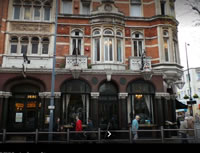Council Rejects Plan to Redevelop Floors Above William Morris Pub
Plan was to turn offices into flats and add two extra storeys above King Street
Hammersmith and Fulham Council has refused permission for the floors above the William Morris Pub at 2- 4 King Street to be changed from office to residential use and to be partially demolised and rebuilt with two additional floors.
The application read as follows:
Change of use of second floor from Class B1 office/Class D1 educational use to Class C3 residential use comprising units made up of 6 x one bedroom flats, 1 x two bedroom flats and 1 x three bedroom flat; erection of two additional storeys to No.4 King Street following removal of the existing roof and partial demolition at first and second floor levels; erection of a three storey rear extension to No.2 King Street fronting Beadon Road following partial demolition of existing back addition; cladding of the upper floors of the King Street frontage to No. 4 King Street with glazed tiles; alterations to ground floor front elevation of Beadon Road building; No.2 King Street fronting Beadon Road upper floor facade are to be in dark anodised metal finishes; The extension flank elevations are to be light coloured anodised metal finishes.
However, this week the application was refused by the council on a number of grounds, including the fact that it would harm the adjacent pub, the Grade II listed Swan.
The refusal read as follows:
The proposed development would cause harm to visual amenity; harm to the character and appearance of the Buildings of Merit at 2-4 King Street (which include the frontage to Beadon Road); harm to the character and appearance of the Hammersmith Broadway Conservation Area and harm to the setting of the adjacent Grade II listed building (The Swan Public House).
The harm would not be outweighed by public benefits, which would not result in sustainable development. More particularly, the scheme represents an overdevelopment of the site, resulting in extensions of excessive height, scale and mass which would not be compatible with the character, design and scale of the existing Buildings of Merit and which would form a discordant and overdominant element at high level in the streetscene in views from within the Hammersmith Broadway Conservation Area on Beadon Road.
The proposed development would result in harm to the character and appearance of the Hammersmith Broadway Conservation Area, which it is desirable to preserve in accordance with s.72 of the Planning (Listed Buildings and Conservation Areas) Act 1990 and harm to the setting of the adjacent Grade II listed building (The Swan Public House), which it is desirable to preserve in accordance with s.66 of the Planning (Listed Buildings and Conservation Areas) Act 1990.
The proposal is therefore considered to be contrary to policies BE1 and H3 of the Core Strategy (2011), policies DM G3 and DM G7 of the Development Management Local Plan (2013), policy 3.4 of the London Plan (as amended in 2016), Design Policies 21, 31, 32, 34 and 46 of the Planning Guidance SPD (2013) and contrary to the National Planning Policy Framework (2012) including paras 64 and 134. 2)
The proposed development is unacceptable with regard to quality of life of future residential occupiers. More particularly, the internal arrangements of the new dwellings together with the physical constraints of the site combine to provide an inappropriate residential unit which would afford an unacceptable level of amenity to prospective occupiers, in terms of substandard floorspace.
Furthermore, the proposed density of 1187.5 hr/ha, is well in excess of the London Plan density range of 200-700 hr/ha. In this respect the development is considered to be contrary to Policy H3 of the Core Strategy (2011), policy DMA2 of the Development Management Local Plan (2013), Policies 3.4 and 3.5 of the London Plan (as amended in 2016), and The Mayor's Housing Supplementary Planning Guidance (2016).
The William Morris, currently owned by JD Wetherspoon and Nicholson's pub The Swan are Hammersmith's most central pubs, sitting next door to each other on the corner of King Street and Hammersmith Broadway.
The Grad II listed Swan says of its history: " Its first portrait was as a coaching inn known as the 'Old Swan', functioning as the first stop from the City of London in 18th Century, refurbishment then fashioned it into the 'White Swan', while later renovations shaped it into the Swan Hotel. However, the railway's arrival in Hammersmith meant demolishing the original premises and the current building was designed from a blank canvas.
"It has always been central to travellers, feeding their imagination during their stay. Those who stayed longer made the town into the home for creative industries, such as The Silver Studio that designed textile patterns for Liberty of London.
"The rich tapestry of this inspirational home also attracted great luminaries of the Arts & Crafts movement, such as William Morris and also Edward Johnstone, designer of the famous London Underground "Bulls Eye" symbol. This artistic heritage also extended to Gustav Holst, (composer of the Planets) whose composition 'Hammersmith' reflected his impressions of the town where he worked."
June 23, 2014
